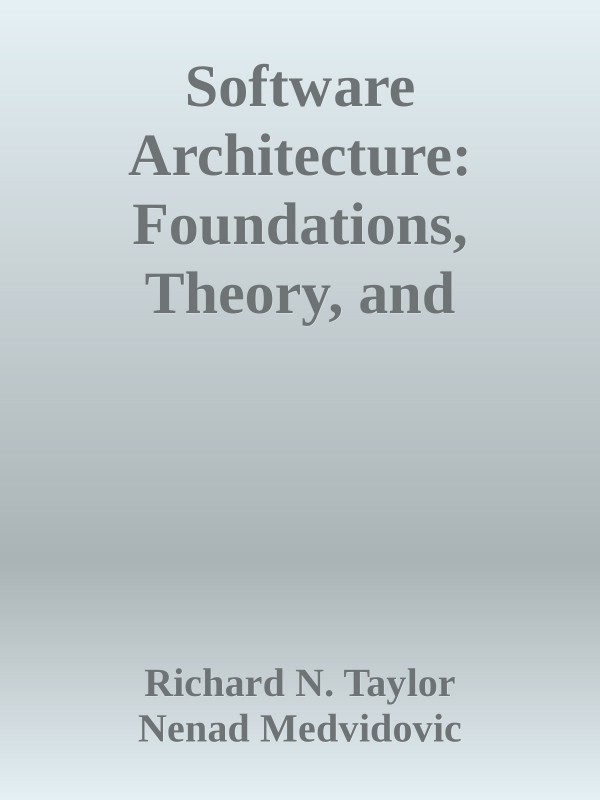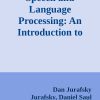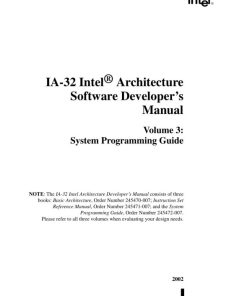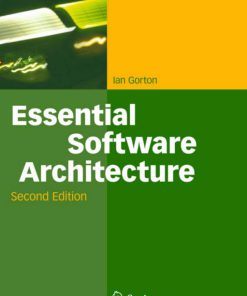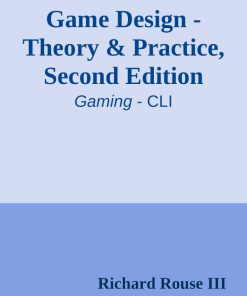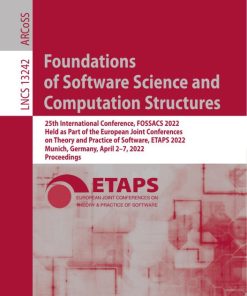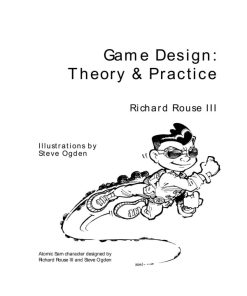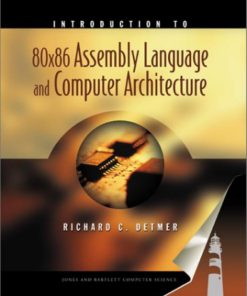Software Architecture Foundations Theory and Practice 1st Edition by Richard Taylor, Nenad Medvidovic, Eric Dashofy ISBN 9781119115809 1119115809
$50.00 Original price was: $50.00.$25.00Current price is: $25.00.
Authors:Richard N. Taylor; Nenad Medvidovic; Eric Dashofy , Series:IT & Computer [220] , Tags:Computers; Software Development & Engineering; General; Programming , Author sort:Taylor, Richard N. & Medvidovic, Nenad & Dashofy, Eric , Ids:Google; 9780470167748 , Languages:Languages:eng , Published:Published:Jan 2009 , Publisher:John Wiley & Sons , Comments:Comments:Software architecture is foundational to the development of large, practical software-intensive applications. This brand-new text covers all facets of software architecture and how it serves as the intellectual centerpiece of software development and evolution. Critically, this text focuses on supporting creation of real implemented systems. Hence the text details not only modeling techniques, but design, implementation, deployment, and system adaptation — as well as a host of other topics — putting the elements in context and comparing and contrasting them with one another. Rather than focusing on one method, notation, tool, or process, this new text/reference widely surveys software architecture techniques, enabling the instructor and practitioner to choose the right tool for the job at hand. Software Architecture is intended for upper-division undergraduate and graduate courses in software architecture, software design, component-based software engineering, and distributed systems; the text may also be used in introductory as well as advanced software engineering courses.
Software Architecture Foundations Theory and Practice 1st Edition by Richard Taylor, Nenad Medvidovic, Eric Dashofy – Ebook PDF Instant Download/Delivery. 9781119115809 ,1119115809
Full download Software Architecture Foundations Theory and Practice 1st Edition after payment
Product details:
ISBN 10: 1119115809
ISBN 13: 9781119115809
Author: Richard Taylor, Nenad Medvidovic, Eric Dashofy
Software Architecture Foundations Theory and Practice 1st Edition Table of contents:
1: The Big Idea
The Power of Analogy: The Architecture of Buildings
Limitations of the Analogy
So, What’s the Big Idea?
The Power and Necessity of Big Ideas: The Architecture of the Web
The Power of Architecture in the Small: Architecture on the Desktop
The Power of Architecture in Business: Productivity and Product Lines
End Matter
Review Questions
Exercises
Further Reading
2: Architectures in Context: The Reorientation of Software Engineering
Fundamental Understandings
Requirements
Design
Design Techniques
Implementation
Implementation Strategies
Analysis and Testing
Evolution and Maintenance
Processes
The Turbine Visualization
Example Process Depictions
End Matter
Review Questions
Exercises
Further Reading
3: Basic Concepts
Terminology
Architecture
Component
Connector
Configuration
Architectural Style
Architectural Pattern
Models
Processes
Stakeholders
End Matter
Review Questions
Exercises
Further Reading
4: Designing Architectures
The Design Process
Architectural Conception
Fundamental Conceptual Tools
The Grand Tool: Refined Experience
Refined Experience in Action: Styles and Architectural Patterns
Domain Specific Software Architectures
Architectural Patterns
Introduction to Styles
Simple Styles
More Complex Styles
Discussion: Patterns and Styles
Design Recovery
Architectural Conception in Absence of Experience: Unprecedented Design
Putting it All Together: Design Processes Revisited
Insights from Requirements
Insights from Implementation
End Matter
Review Questions
Exercises
Further Reading
5: Connectors
Connectors in Action: A Motivating Example
Connector Foundations
Connector Roles
Connector Types and Their Variation Dimensions
Procedure Call Connectors
Event Connectors
Data Access Connectors
Linkage Connectors
Stream Connectors
Arbitrator Connectors
Adaptor Connectors
Distributor Connectors
Example Connectors
Event-Based Data Distribution Connectors
Grid-Based Data Distribution Connectors
Client-Server–Based Data Distribution Connectors
P2P-Based Data Distribution Connectors
Using the Connector Framework
Selecting Appropriate Connectors
Detecting Mismatches
End Matter
Review Questions
Exercises
Further Reading
6: Modeling
Modeling Concepts
Stakeholder-Driven Modeling
Basic Architectural Concepts
Elements of the Architectural Style
Static and Dynamic Aspects
Functional and Non-Functional Aspects
Ambiguity, Accuracy, and Precision
Ambiguity
Accuracy and Precision
Complex Modeling: Mixed Content and Multiple Views
Views and Viewpoints
Consistency among Views
Evaluating Modeling Techniques
Specific Modeling Techniques
Generic Techniques
Early Architecture Description Languages
Domain- and Style-Specific ADLs
Extensible ADLs
When Systems Become Too Complex to Model
End Matter
Review Questions
Exercises
Further Reading
7: Visualization
Visualization Concepts
Canonical Visualizations
Textual Visualizations
Graphical Visualizations
Hybrid Visualizations
The Relationship between Visualizations and Views
Evaluating Visualizations
Constructing a Visualization
Coordinating Visualizations
Beyond Design: Using Visualization Dynamically
Common Issues in Visualization
Same Symbol, Different Meaning
Differences without Meaning
Decorations without Meaning
Borrowed Symbol, Different Meaning
Evaluating Visualization Techniques
Techniques
Textual Visualizations
Informal Graphical Editors
UML: The Unified Modeling Language
Rapide
The Labeled Transition State Analyzer (LTSA)
xADL 2.0
End Matter
Review Questions
Exercises
Further Reading
8: Analysis
Analysis Goals
Completeness
Consistency
Compatibility
Correctness
Scope of Analysis
Component- and Connector-Level Analysis
Subsystem- and System-Level Analysis
Data Exchanged in the System or Subsystem
Architectures at Different Abstraction Levels
Comparison of Two or More Architectures
Architectural Concern being Analyzed
Level of Formality of Architectural Models
Type of Analysis
Level of Automation
System Stakeholders
Analysis Techniques
Inspections and Reviews
Model-Based Analysis
Simulation-Based Analysis
End Matter
Review Questions
Exercises
Further Reading
9: Implementation
Concepts
The Mapping Problem
Architecture Implementation Frameworks
Evaluating Frameworks
Middleware, Component Models, and Application Frameworks
Building a New Framework
Concurrency
Generative Technologies
Ensuring Architecture-to-Implementation Consistency
Existing Frameworks
Frameworks for the Pipe-and-Filter Architectural Style
Frameworks for the C2 Architectural Style
Examples
Implementing Lunar Lander in the Pipe-and-Filter Style Using the java.io Framework
Implementing Lunar Lander in the C2-Style Using the Lightweight C2 Framework
End Matter
Review Questions
Exercises
Further Reading
10: Deployment and Mobility
Overview of Deployment and Mobility Challenges
Software Architecture and Deployment
Basic Concepts
Deployment Activities
Tool Support
Software Architecture and Mobility
Basic Concepts
Mobility Paradigms
Challenges in Migrating Code
End Matter
Review Questions
Exercises
Further Reading
11: Applied Architectures and Styles
Distributed and Networked Architectures
Limitations of the Distributed Systems Viewpoint
Architectures for Network-Based Applications
The REpresentational State Transfer Style (REST)
Commercial Internet-Scale Applications
Decentralized Architectures
Shared Resource Computation: The Grid World
Peer-to-Peer Styles
Summary Notes on Latency and Agency
Service-Oriented Architectures and Web Services
Architectures from Specific Domains
Robotics
Wireless Sensor Networks
End Matter
Review Questions
Exercises
Further Reading
12: Designing for Non-Functional Properties
Efficiency
Software Components and Efficiency
Software Connectors and Efficiency
Architectural Configurations and Efficiency
Complexity
Software Components and Complexity
Software Connectors and Complexity
Architectural Configurations and Complexity
Scalability and Heterogeneity
Software Components and Scalability
Software Connectors and Scalability
Architectural Configurations and Scalability
Adaptability
Software Components and Adaptability
Software Connectors and Adaptability
Architectural Configurations and Adaptability
Dependability
Software Components and Dependability
Software Connectors and Dependability
Architectural Configurations and Dependability
End Matter
Review Questions
Exercises
Further Reading
13: Security and Trust
Security
Design Principles
Architectural Access Control
Access Control Models
Connector-Centric Architectural Access Control
Trust Management
Trust
Trust Model
Reputation-Based Systems
Architectural Approach to Decentralized Trust Management
End Matter
Review Questions
Exercises
Further Reading
14: Architectural Adaptation
Concepts of Architecture-Centric Adaptation
Sources and Motivations for Change
Shearing Layers
Structural Elements Subject to Change
Change Agents and Context
Architecture: The Central Abstraction
A Conceptual Framework for Architectural Adaptation
Techniques for Supporting Architecture-Centric Change
Basic Techniques Corresponding to Activities of the Conceptual Framework
Architectures/Styles that Support Adaptation
The Special Problems of On-the-Fly and Autonomous Adaptation
End Matter
Review Questions
Exercises
Further Reading
15: Domain-Specific Software Engineering
Domain-Specific Software Engineering in a Nutshell
Similar Problems, Similar Solutions
Viewing DSSE through the Prism of Domain, Business, and Technology
Domain-Specific Software Architecture
Domain Knowledge
Canonical Requirements
Canonical Solution Strategies—Reference Architectures
Product Lines and Architecture
Product-Line Concepts
Specifying the Architecture of a Product Line
Capturing Variations Over Time
Using Product Lines as Tools for What-If Analysis
Implementing Product Lines
Unifying Product Architectures with Different Intellectual Heritage
Organizational Issues in Creating and Managing Product Lines
DSSAs, Product Lines, and Architectural Styles
DSSE Examples
Koala and Consumer Electronics
Software-Defined Radios
End Matter
Review Questions
Exercises
Further Reading
16: Standards
What Are Standards?
Why Use Standards?
Drawbacks of Standards
When to Adopt
Specific Standards
Conceptual Standards
Notational Standards
SysML
Standard Tools
Telelogic System Architect
Process Standards
Rational Unified Process
Model-Driven Architecture
End Matter
Review Questions
Exercises
Further Reading
17: People, Roles, and Teams
Who Are Software Architects?
Architect as a Software Designer
Architect as a Domain Expert
Architect as a Software Technologist
Architect as a Standards Compliance Expert
Architect as a Software Engineering Economist
Some Bad Habits
What Do Software Architects Do?
Develop Project Strategy
Design Systems
Communicate with Stakeholders
Lead
How Do Software Architects Work?
Balance of Skills
Allegiance to the Project
Allegiance to the Organization
Duration of Involvement
Team Structure
How Do Software Architects Relate to Other Stakeholders?
Architects and Engineers
Architects and Managers
Other Stakeholders
Remaining Challenges
End Matter
Review Questions
Further Reading
Bibliography
Index
People also search for Software Architecture Foundations Theory and Practice 1st Edition:
software architecture foundations theory and practice pdf
software architecture foundations theory and practice pdf github
software architecture foundations theory and practice pdf download
software architecture foundations theory and practice pdf free
You may also like…
eBook CHM
Game Design Theory and Practice 2nd Edition by Richard Rouse III ISBN 1556229127 9781556229121

